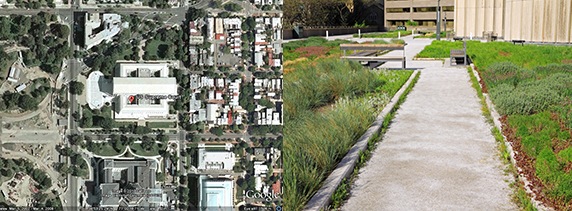White roofs can be more effective at reducing the urban heat-island effect than darker roofs and roofs covered with plants, according to a report by the Lawrence Berkeley National Laboratory. White roofs also cost less.
The report, Economic Comparison of White, Green, and Black Flat Roofs In the United States,says that white roofs are three times more effective than green roofs at “cooling the globe.” Researchers analyzed 22 commercial flat roof projects in the U.S. and performed a 50-year life cycle cost analysis.
They assumed a 20-year service life for black roofs and white roofs, and 40 years for green roofs. White roofs save $25 per square meter compared to black roofs and green roofs cost $71 per square meter more compared to black roofs, the report says.
Green roofs provide benefits that white roofs do not offer, however, such as controlling runoff and curbing air pollution.
Related Stories
Codes and Standards | Sep 15, 2020
Taller timber buildings approved in National Fire Protection Association code
Ensures compatibility with the International Building Code.
Codes and Standards | Sep 14, 2020
Relocation of neighborhoods, the next step in U.S. flood strategy, is underway
Repeated rebuilding after successive floods now seen as bad policy.
Codes and Standards | Sep 10, 2020
Fannie Mae programs provide incentives for multifamily solar
Affordable housing projects can find PV installations to be cost-effective.
Codes and Standards | Sep 9, 2020
Corporate pledges accelerate net-zero building movement
World Green Building Council drives goal of net-zero carbon emissions by 2050.
Codes and Standards | Sep 8, 2020
Study will examine elevator airflow amid COVID-19 pandemic
Researchers to investigate risk of airborne transmission.
Codes and Standards | Sep 4, 2020
Updated selection, application guide for plastic glazed skylights, sloped glazing released
Part of suite of skylight documents by Fenestration and Glazing Industry Alliance.
Codes and Standards | Sep 3, 2020
Turner Construction takes strong stand against racism
Shuts down work sites for anti-bias training.
Codes and Standards | Sep 2, 2020
California releases guide for state water policy
Water Resilience Portfolio is roadmap for meeting water needs as climate changes.
Codes and Standards | Aug 31, 2020
Fenestration alliance updates fenestration sealants guide
First update to 2009 document.
Codes and Standards | Aug 25, 2020
Platform will allow researchers to test energy system integration at scale
The U.S. Department of Energy’s (DOE’s) National Renewable Energy Laboratory (NREL) recently launched the Advanced Research on Integrated Energy Systems (ARIES) platform.

















